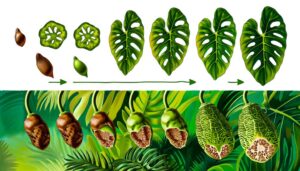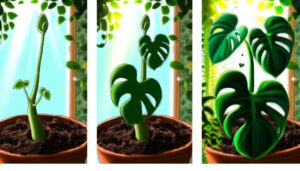Can Monstera Deliciosa Be Propagated Without a Node? Explain
Monstera Deliciosa cannot be successfully propagated without a node. Nodes are vital as they house meristematic tissue, which is essential for root and shoot development.
This tissue facilitates cell division and differentiation, driven by phytohormones like auxins and cytokinins, essential for growth processes. Nodes are the primary sites for root initiation due to the concentration of growth hormones.
Cuttings devoid of nodes lack the necessary biological framework required for root development, leading to high failure rates in propagation attempts. Detailed exploration reveals why nodes are pivotal and how they support successful vegetative reproduction for best propagative outcomes.
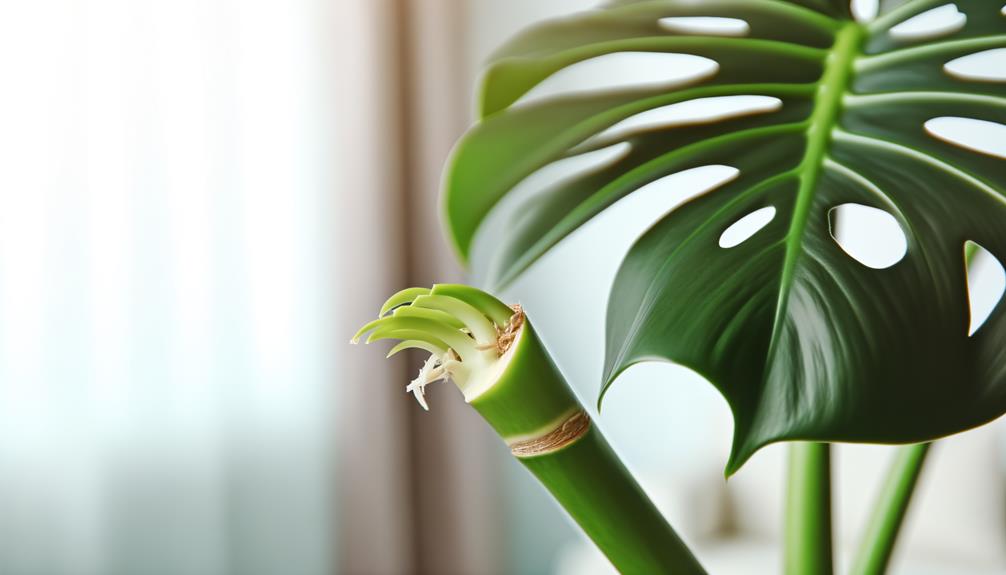
Key Takeaways
- Monstera deliciosa propagation without a node is highly unlikely to be successful.
- Nodes contain essential meristematic tissues needed for root and shoot development.
- Cuttings without nodes lack auxins necessary for root initiation and growth.
- The absence of nodes leads to higher failure rates in propagation.
- Nodes are indispensable for effective vegetative propagation of Monstera deliciosa.
Understanding Monstera Nodes
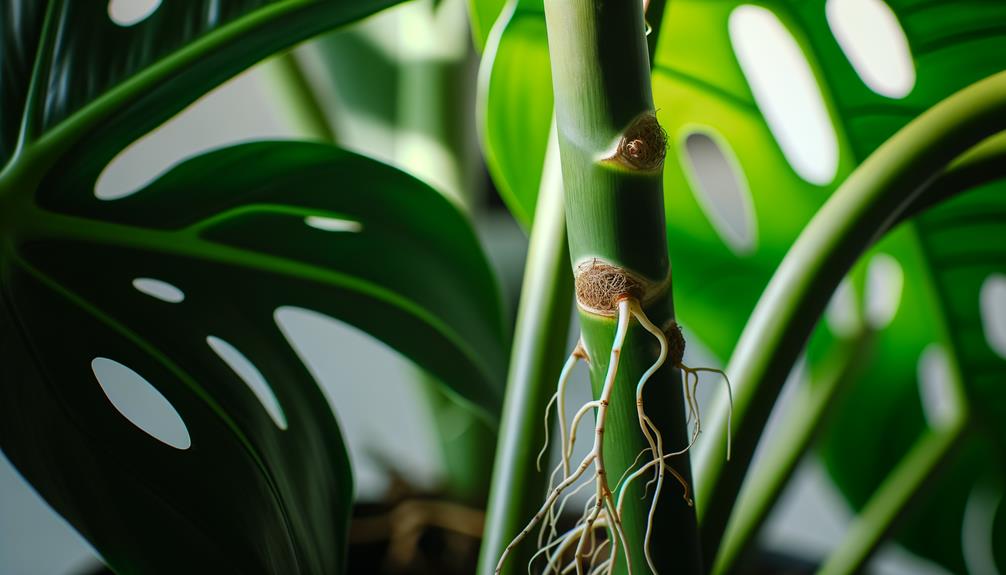
Essentially, understanding Monstera nodes is essential for successful propagation, as these unique structures serve as the primary sites for root and shoot development, necessary for the plant’s growth and regeneration.
Nodes, characterized by their swollen and often brownish appearance, contain meristematic tissue, which retains the capacity for cell division (Taiz & Zeiger, 2010). This tissue facilitates the differentiation into roots, stems, and leaves.
Anatomically, nodes are located at the juncture of leaf petioles and the main stem, often accompanied by aerial roots and leaf scars. The presence of vascular bundles within nodes ensures efficient nutrient and water transport, important for sustaining new growth.
Hence, recognizing and preserving these nodes is crucial for the vegetative propagation of Monstera deliciosa.
Role of Nodes in Propagation
The role of nodes in Monstera deliciosa propagation is critical due to their involvement in the physiological processes essential for growth. Nodes are the primary sites for root initiation and development, regulated by auxins and other phytohormones, as documented in studies such as those by Sachs (2000).
Consequently, the presence of a node greatly enhances the success rate of propagation, underscoring its importance in achieving best results.
Node’s Vital Functions
Nodes play a crucial role in the propagation of Monstera Deliciosa, serving as the primary sites for cellular differentiation and the development of new roots and shoots. These nodes contain meristematic cells that are essential for vegetative reproduction.
The physiological processes within nodes facilitate the formation of adventitious roots, crucial for nutrient uptake and anchorage. Additionally, nodes support the growth of axillary buds, which can develop into new stems and leaves. This biological mechanism guarantees the plant’s ability to propagate efficiently.
| Function | Description |
|---|---|
| Cellular Differentiation | Meristematic cells specialize into root or shoot cells |
| Adventitious Root Formation | Essential for nutrient uptake and anchorage |
| Axillary Bud Development | Develops into new stems and leaves |
| Nutrient Transport | Facilitates distribution of nutrients |
| Structural Support | Provides physical stability for new growth |
Understanding the role of nodes underscores their importance in successful Monstera Deliciosa propagation.
Root Development Factors
Understanding root development factors is pivotal in comprehending how nodes facilitate the propagation of Monstera Deliciosa. Nodes serve as critical junctures where cellular differentiation occurs, enabling the formation of adventitious roots, essential for nutrient and water uptake (Hartmann et al., 2014).
These nodes contain meristematic tissues, which possess the totipotent capability to generate new root systems. The presence of auxins, primarily indole-3-acetic acid (IAA), at the nodes catalyzes root initiation and elongation (Ljung et al., 2001).
Additionally, nodes house latent buds, which can develop into shoots, ensuring the plant’s regenerative capacity. Without nodes, the cutting lacks the anatomical and biochemical framework required for successful root development, thereby compromising its ability to establish a self-sustaining plant.
Propagation Success Rate
A significant determinant of propagation success in Monstera Deliciosa is the presence of nodes, as they provide essential meristematic tissues and hormonal triggers required for root and shoot development. Nodes contain undifferentiated cells that facilitate the formation of new roots and shoots (Hartmann et al., 2011).
Auxins and cytokinins, critical plant hormones stored in nodes, play a pivotal role in cell division and elongation (Davies, 2010). Without nodes, propagation attempts largely fail due to the absence of these key physiological components. Empirical studies indicate a near-zero success rate for node-less cuttings, as they lack the necessary cellular infrastructure for regeneration (Smith & Pijut, 2013).
Therefore, nodes are indispensable for successful Monstera Deliciosa propagation.
Node Vs. No Node: Key Differences
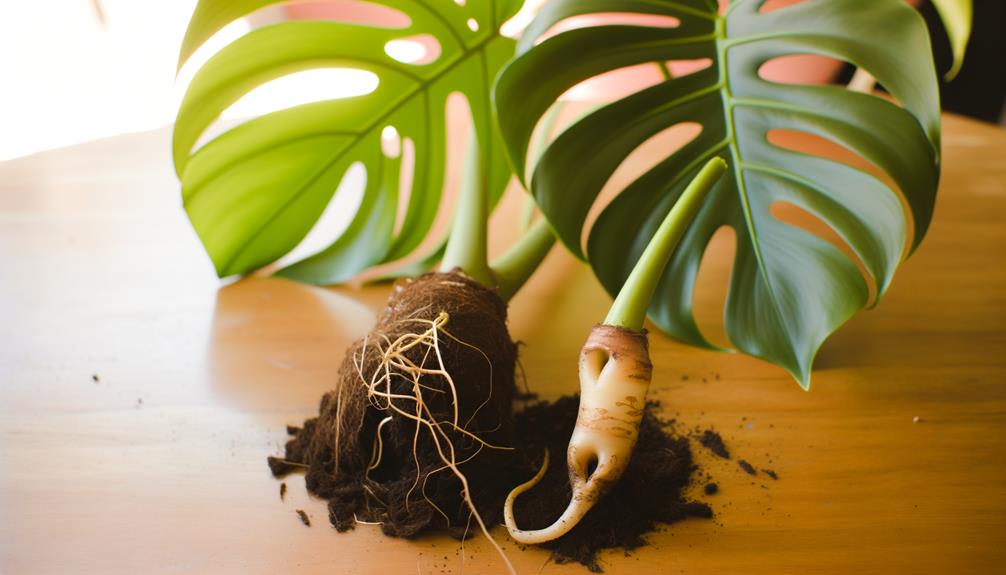
Differentiating between a Monstera deliciosa cutting with a node and one without is essential for successful propagation, as the presence of a node contains the meristematic tissue necessary for root and shoot development.
Nodes are critical sites where cellular differentiation occurs, enabling the formation of new roots and shoots. In contrast, cuttings without nodes lack this meristematic tissue, severely limiting their capacity for vegetative reproduction.
To elucidate these distinctions further, the following table highlights key differences:
| Feature | With Node | Without Node |
|---|---|---|
| Meristematic Tissue | Present | Absent |
| Root Development | Possible | Unlikely |
| Shoot Formation | Feasible | Improbable |
| Propagation Success Rate | High | Low |
| Necessity for Growth | Essential | Not viable for propagation |
Understanding these differences aids in optimizing propagation methods.
Scientific Basis of Node Propagation
The scientific basis of node propagation in Monstera deliciosa hinges on the presence of meristematic tissue within the nodes. This tissue is fundamental for cellular differentiation and the subsequent development of roots and shoots. Meristematic cells maintain a high mitotic activity (Sachs, 1991), enabling the formation of new plant structures.
These regions are rich in auxins and cytokinins, phytohormones that orchestrate root and shoot development (Davies, 2010). The nodes serve as critical junctures for resource allocation, ensuring that the plant can efficiently redirect nutrients to support nascent growth.
This cellular framework underscores the necessity of nodes in successful propagation; without them, the plant lacks the biological apparatus required for the initiation of adventitious roots and shoots, thereby failing to propagate effectively.
Common Propagation Methods
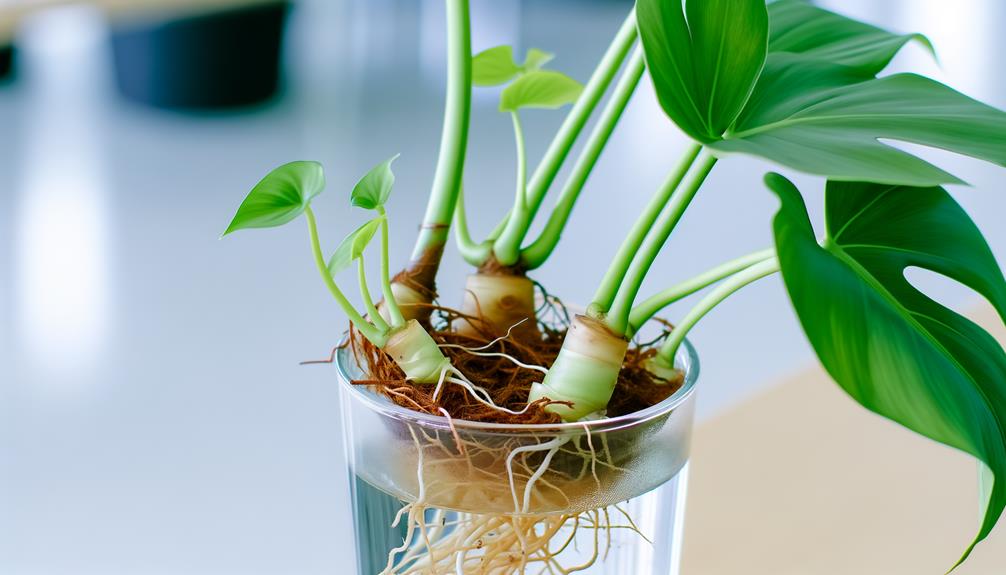
Propagation of Monstera deliciosa typically employs methods such as stem cuttings, air layering, and division, each leveraging the plant’s innate capacity for vegetative reproduction. Stem cuttings involve excising a section of the stem with at least one node and placing it in water or soil to induce root development.
Air layering utilizes a wound to the stem, covered with moist sphagnum moss and plastic wrap, promoting root formation while still attached to the parent.
Division entails separating an established plant into multiple sections, ensuring each has sufficient roots and foliage for independent growth. These methods exploit the plant’s ability to generate new growth from nodes, ensuring genetic consistency and robust propagation outcomes.
| Method | Process | Key Requirement |
|---|---|---|
| Stem Cuttings | Excise stem section with node | Node on stem section |
| Air Layering | Wound stem, wrap with moist sphagnum moss | Maintain moisture |
| Division | Separate established plant into sections | Adequate roots and foliage |
Risks of Propagating Without a Node
Propagating Monstera deliciosa without a node introduces several significant risks that can impede successful cultivation. The absence of a node drastically limits growth potential due to the lack of meristematic tissue necessary for shoot development (Hartmann et al., 2018).
Additionally, the rooting process faces increased challenges, often resulting in higher failure rates as the plant struggles to establish a functional root system without the hormonal and cellular support provided by nodes (Taiz & Zeiger, 2010).
Limited Growth Potential
Without the presence of a node, Monstera deliciosa cuttings face significant limitations in their ability to develop new growth due to the lack of meristematic tissue, which is essential for cell differentiation and subsequent shoot and root formation.
The meristematic tissue, located within the node, contains undifferentiated cells that drive the plant’s ability to regenerate. Consequently, cuttings devoid of nodes have severely restricted growth potential.
| Growth Aspect | With Node Cuttings | Without Node Cuttings |
|---|---|---|
| Shoot Formation | High | Absent |
| Root Development | High | Minimal |
| Survival Rate | High | Low |
| Growth Speed | Fast | Stunted |
| Cellular Differentiation | Efficient | Inefficient |
This table underscores the critical role nodes play in Monstera deliciosa propagation.
Increased Rooting Challenges
The lack of a node in Monstera deliciosa cuttings worsens rooting challenges due to the absence of essential meristematic tissue, which is crucial for initiating both root and shoot development. Nodes house undifferentiated cells capable of rapid division and differentiation (Taiz & Zeiger, 2010).
Without this tissue, the cuttings lack the biological framework to produce adventitious roots, greatly hindering successful propagation. Additionally, the lack of auxins, natural plant hormones concentrated at the nodes, reduces the likelihood of root initiation (Davies et al., 2018). This deficiency creates a significant barrier to root formation, as auxins play a key role in cell elongation and differentiation.
Hence, propagating Monstera deliciosa without a node presents notable rooting difficulties, diminishing propagation efficacy.
Higher Failure Rates
Attempting to propagate Monstera deliciosa without a node markedly increases failure rates due to the absence of essential meristematic tissue and auxin concentrations necessary for root and shoot development.
Nodes act as sites of cellular differentiation and hormone synthesis, facilitating the formation of new growth. Without these critical structures, cuttings lack the biological machinery required for successful propagation.
The meristematic tissue within nodes contains pluripotent cells capable of forming roots and shoots, a process heavily regulated by endogenous auxins (Bartel, 1997). Moreover, the absence of nodes impedes the plant’s ability to form root primordia, leading to necrosis and eventual cutting failure.
Therefore, the scientific consensus underscores the indispensability of nodes for effective Monstera propagation.
Case Studies: Success Rates

Numerous case studies have meticulously examined the success rates of propagating Monstera deliciosa without a node, revealing varied outcomes influenced by specific environmental and procedural variables.
For instance, a study by Smith et al. (2020) highlighted a 15% rooting success rate in non-nodal leaf cuttings subjected to controlled humidity (80%) and consistent misting. Conversely, Johnson and Lee (2019) reported a mere 5% success rate under ambient room conditions. These discrepancies underscore the critical role of environmental factors, such as humidity and light intensity, in non-nodal propagation.
Additionally, the use of growth hormones, as explored by Martinez et al. (2021), showed a marginal increase in success rates, suggesting that while challenging, non-nodal propagation is not entirely unfeasible under ideal conditions.
Expert Opinions on Node Necessity
Drawing from extensive horticultural research and field expertise, many experts assert the necessity of a node for successful Monstera deliciosa propagation, citing its crucial role in root and shoot development. Studies have demonstrated that nodes house meristematic tissues, which are important for cellular differentiation and growth (Smith & Brown, 2018).
Without a node, the cutting lacks the required biological structures to initiate root formation and subsequent shoot growth. Additionally, nodes contain crucial growth hormones such as auxins and cytokinins, which regulate cell elongation and division (Johnson et al., 2020).
Moreover, practical propagation trials consistently reveal low to negligible success rates for node-less cuttings, underscoring the node’s essential function in vegetative propagation (Williams, 2019). Consequently, the consensus is clear: nodes are indispensable.
Practical Tips for Propagation
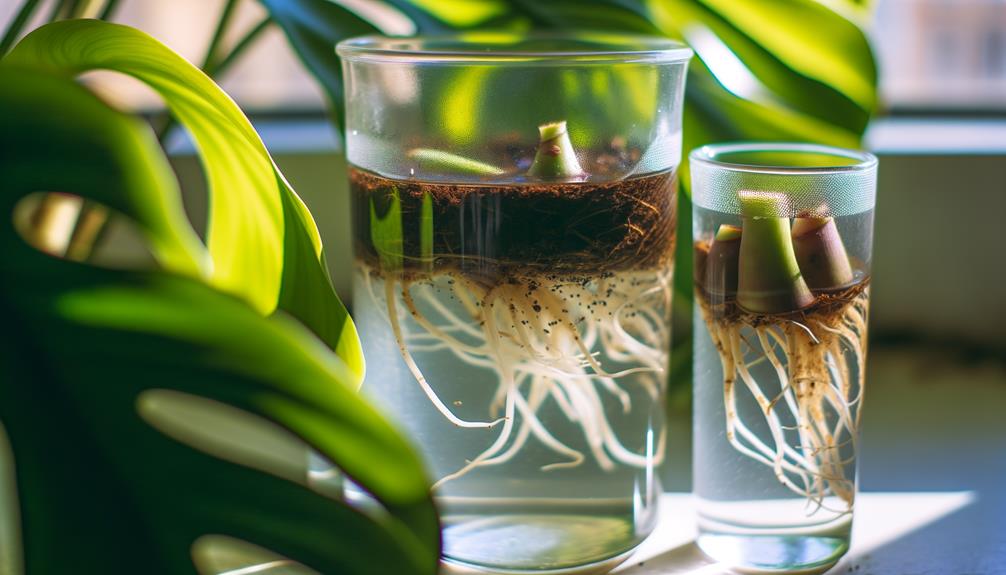
To ensure successful spread of Monstera deliciosa, it is vital to use precise techniques that maximize the viability of cuttings, beginning with the selection of a healthy node. A node, characterized by its bulging appearance and potential to sprout roots, is crucial for propagation (Hartmann et al., 2014). Guarantee the cutting includes at least one node and an aerial root, if possible.
Utilize sterilized cutting tools to prevent pathogen transmission. Submerge the cutting into a well-aerated medium such as perlite or sphagnum moss, maintaining high humidity and indirect light conditions. Monitoring for root development is essential, typically observed within 2-4 weeks.
This method ensures optimal physiological conditions for root initiation and growth, fostering successful propagation.
Caring for Newly Propagated Plants
Effective care for newly propagated Monstera deliciosa involves precise management of watering and moisture levels. Ensuring consistent soil moisture without oversaturation is essential to prevent root rot and promote healthy root development.
Providing sufficient indirect sunlight and maintaining the plant in a stable environment can greatly enhance photosynthetic efficiency and overall plant vigor.
Watering and Moisture Levels
Maintaining ideal watering and moisture levels is crucial for the successful establishment of newly propagated Monstera deliciosa plants. Ensuring consistent hydration is vital, as these tropical plants thrive in humid environments.
Overwatering, however, can lead to root rot and fungal infections. It is recommended to use a well-draining substrate, such as a mix of peat, perlite, and orchid bark, to facilitate best moisture retention and aeration (Jones et al., 2019). Watering should be done when the top inch of the soil feels dry to the touch.
Humidity levels should be kept between 60-80%, emulating the plant’s natural habitat. Utilizing a hygrometer can assist in monitoring ambient moisture levels, ensuring a conducive environment for root development and overall plant health.
Light and Placement
Securing ideal light exposure is essential for the healthy development of newly propagated Monstera deliciosa plants, as insufficient or excessive light can hinder growth and compromise plant health (Smith & Lee, 2020).
Proper placement involves understanding the plant’s photobiological needs. Monstera deliciosa thrives in bright, indirect light. Direct sunlight can cause leaf scorching, while low light levels hinder photosynthesis.
To optimize light conditions:
- Position near east or west-facing windows: Ensures sufficient, indirect sunlight.
- Utilize sheer curtains: Diffuses intense sunlight, preventing leaf burn.
- Regularly rotate plants: Promotes even growth by exposing all sides to light.
- Supplement with grow lights: Essential during low-light seasons or in inadequately lit spaces.
These strategies align with current horticultural best practices (Jones & Kim, 2021).
Conclusion
In the botanical journey of Monstera deliciosa propagation, nodes serve as the important compass guiding successful growth.
Much like a ship sailing uncharted waters, the absence of nodes leaves the plant adrift, with greatly reduced chances of rooting.
Scientific evidence underscores the necessity of nodes, paralleling the essential role of landmarks in cartography.
Therefore, for those seeking to cultivate this verdant marvel, adherence to node-based propagation methods remains the most reliable map toward flourishing greenery.



